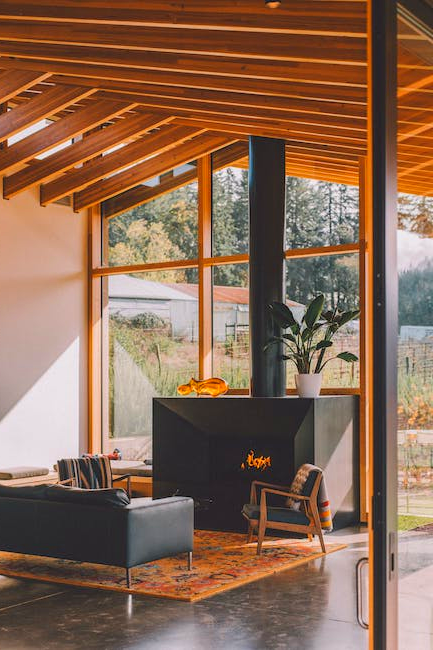In the ever-changing world of interior design, **artificial intelligence** is a real game-changer. There’s a big shift happening; AI tools, with their user-friendly interfaces and rich databases, are transforming how we design and imagine our homes. AI offers the chance to create endless design possibilities, bringing a level of flexibility and creativity that wasn’t possible before.
Our capacity to visualize and execute design concepts has been dramatically enhanced by various AI interior design tools. These platforms employ artificial intelligence to interpret our preferences and generate design layouts that mirror our taste and functional requirements. Whether we are professional designers seeking efficiency or homeowners exploring personal aesthetics, AI provides us with a suite of options to bring our vision to fruition with greater accuracy and less effort.
Among these technological innovations, certain AI tools have risen to the forefront due to their exceptional features and user experiences. We find applications that cater to both novices and experts, each designed to simplify the design process while delivering sophisticated and personalized results. As we embrace these advancements, we harness the power of AI to reinvent our environments with unprecedented precision and artistry.
Benefits of AI in Interior Design
In the innovative field of interior design, we harness the power of AI to bring about transformative benefits that streamline the creative process. Here are key advantages we experience through the integration of AI:
Time Efficiency: AI significantly reduces the time required to conceptualize and visualize design projects. By automating mundane tasks, we can focus on the creative aspects, ensuring projects are completed faster.
Cost-Effective Solutions: The use of AI eliminates the need for multiple revisions and physical models, saving us money. With AI, we make more informed decisions early in the design phase, reducing the likelihood of costly errors.
- Enhanced Creativity: AI tools provide us with vast databases of design elements, enabling us to experiment and combine various styles effortlessly. This leads to more innovative and personalized designs.
Accessibility: AI design tools are accessible to both professionals and novices. We can submit images of our space to AI platforms, choose our preferred styles, and receive tailored design recommendations without prior expertise.
Data-Driven Decisions: AI helps us make decisions backed by data. By analyzing past trends and current preferences, AI can suggest optimal design solutions that cater to our specific tastes.
- Precision and Detail: AI applications help us in achieving a higher level of precision in design. These tools can generate detailed models and renderings that accurately reflect our envisioned spaces.
By embracing AI, we streamline the design process, amplify our creative potential, and ensure that our projects are both aesthetically pleasing and functionally optimized.
AI Tools for Visual Rendering
In this section, we provide an overview of AI-driven tools tailored for visual rendering in interior design. These applications enhance our ability to create accurate and lifelike images, transforming ideas into virtual realities.
3D Modeling Software
3D modeling software has significantly benefited from the integration of AI, allowing us to produce detailed and photorealistic models efficiently. Advanced AI algorithms assist in interpreting design elements, optimizing textures, and simulating lighting effects to produce high-quality renders. For instance:
- Homestyler: This web-based tool facilitates quick creation of 2D and 3D designs, employing AI to streamline the design process.
- DreamStaging.AI: Offers a user-friendly platform for virtual staging, enabling the easy visualization of various styles and room types.
Virtual Reality Applications
Virtual Reality (VR) applications powered by AI are transforming our approach to interior design visualization. AI enhances these VR tools by rapidly generating immersive environments that we can interact with in real-time, offering a more dynamic understanding of space and design elements. Key applications include:
- Fotor AI Room Planner: Simplifies room planning by generating three-dimensional virtual environments to explore different design possibilities.
- Oda Moodboard: Utilizes AI to help create mood boards that can be experienced in a virtual space, providing a unique perspective on the proposed aesthetic and atmosphere.
Machine Learning for Personalized Design
In this section, we’ll explore how machine learning (ML) is revolutionizing interior design by focusing on user preferences and optimizing space utilization.
User Preference Analysis
Machine learning algorithms are adept at sifting through user data to discern individual styles and preferences. We use these advanced systems to analyze patterns in user behavior, color choices, furniture selection, and design styles to create highly personalized design options. For instance:
- Color and Style Preferences: Algorithms analyze previous choices to suggest harmonious color palettes and design motifs.
- Furniture Preferences: Machine learning tools can recommend furniture pieces that match users’ style preferences and purchase history.
Space Utilization Optimization
Optimizing space utilization is crucial for functional and aesthetically pleasing design. Machine learning excels at this by:
- Layout Analysis: It evaluates room dimensions and suggests the most efficient layouts.
- Functionality Optimization: ML algorithms take into account the intended use of each space, offering designs that meld form with function.
Intelligent Design Assistance
In the realm of AI interior design, we find tools offering unprecedented support in crafting functional and aesthetically pleasing spaces. Our focus here centers on two pivotal features—automated layout generators and color scheme selectors—both integral to modern design processes.
Automated Layout Generators
Automated layout generators utilize AI algorithms to create room layouts based on specified dimensions and user preferences. This sophisticated software can swiftly propose optimized arrangements of furniture and accessories, considering both form and function. Users can expect features like:
- Space Optimization: Makes efficient use of the available space, considering traffic flow and focal points.
- Furniture Placement Suggestions: Automatically suggests layouts that align with design principles.
An example of an AI tool with such capabilities includes Planner 5D RoomGPT, which allows for rapid visualization and iteration of room layouts without the need for a professional designer’s constant input.
Color Scheme Selectors
Color scheme selectors employ AI to analyze and suggest harmonious color palettes for interior spaces, based on desired moods or themes. Key features often include:
- Mood-Based Selections: Recommendations for color schemes that evoke specific emotions or atmospheres.
- Adaptational Color Recommendations: Suggests colors based on natural lighting and room size.
Tools like the Homestyler offer the ability to try different color combinations in real-time, giving users the chance to visualize the results instantly before deciding on their final choices. This streamlined process greatly simplifies one of the most complex aspects of interior design.
AI Integration with Smart Home Technology
In the realm of interior design, we are experiencing a groundbreaking shift with the integration of smart home technology and artificial intelligence (AI). Our environments are becoming more responsive and tailored to our preferences, thanks to AI’s capability to learn and adapt.
We witness AI’s impact in several key areas:
- Automated Control Systems: These systems learn our habits and adjust lighting, temperature, and even window shades for optimal comfort and efficiency, often without our direct input.
- Personalized User Experiences: AI algorithms can suggest design modifications based on our behavior and preferences, ensuring our living spaces adapt to our lifestyles seamlessly.
How AI is Enhancing Smart Home Technology:
| Feature | Description |
|---|---|
| Predictive Maintenance | AI anticipates appliance maintenance needs, ensuring longevity and efficiency. |
| Energy Management | Optimizes energy consumption, leading to reduced costs and environmental impact. |
| Security Improvements | Enhanced security protocols and anomaly detection provide peace of mind. |
We place emphasis on the harmonious blend of aesthetics and functionality, as AI interfaces with smart devices to create cohesive, intelligent, and comfortable living environments. Our focus remains on how these technological advancements can enhance our daily lives, offering personalized and sustainable design solutions.
Challenges and Considerations in AI for Interior Design
As we harness AI in interior design, we must acknowledge the challenges and consider key factors to ensure its effective implementation. Here are some pivotal points to consider:
-
Data Privacy: When AI systems analyze personal spaces, privacy concerns arise. We must ensure that data handling complies with relevant regulations and standards to protect clients’ privacy.
-
Substituting Human Judgment: While AI can provide suggestions based on large datasets, it may lack the nuanced understanding of a client’s unique taste and lifestyle needs. Balancing AI’s efficiency with the irreplaceable human touch is crucial.
-
Dependence and Skill Erosion: Over-reliance on automated tools may lead to a decline in traditional design skills among professionals. Continued education and skill development are essential to keep our craftsmanship alive.
-
Interdisciplinary Knowledge Base: The AI must be trained on diverse architectural and design principles. We need to integrate a comprehensive knowledge base to ensure the AI’s recommendations are theoretically sound and practically applicable.
-
Technical Limitations and Errors: Algorithms may not always interpret client input accurately, resulting in flawed designs. Our vigilance in monitoring and refining AI outputs is necessary to maintain quality standards.
-
Adoption and Adaptation: The shift to AI-driven design requires a cultural change within the industry. We must prepare for the learning curve and invest time in training to adapt to new workflows.
We are committed to navigating these challenges and considerations to optimize AI in interior design, ensuring that it serves as a beneficial tool rather than a hindrance to our creative process.
Frequently Asked Questions
In this section, we cover some of the most pressing inquiries regarding AI in interior design to help you understand the range of tools and their capabilities.
What are the top-rated AI-based interior design apps available?
We recognize Homestyler and Foyr Neo as some of the top-rated AI interior design tools. They offer functionalities such as real-time 3D visualization and a comprehensive library of furniture and decor from real brands.
How can AI software improve the efficiency of interior design processes?
AI enhances the efficiency of design processes by automating space planning, furniture selection, color palettes, and material choices. This accelerates decision-making and reduces manual effort.
What free AI tools are recommended for amateurs in interior design?
For those just starting out, free AI tools like some versions of Homestyler can be incredibly beneficial. They provide ample resources for creating detailed 2D and 3D designs without any investment.
Can artificial intelligence tools fully automate the interior design process?
While AI tools greatly assist with various aspects of interior design, they cannot completely replace the unique insights and expertise of a professional designer. The human touch remains vital, especially when it comes to understanding client preferences and creating bespoke designs.
What are the best AI interior design apps that do not require user registration?
There are AI interior design tools available that allow users to explore and use basic features without needing to register. Searching for ‘no-registration AI design tools’ should provide accessible options for those preferring anonymity or a quick trial.
How can one utilize advanced AI like ChatGPT in the field of interior design?
Advanced AI such as ChatGPT can assist by offering personalized design suggestions, generating creative concepts, and even providing tips on design elements compatibility. It serves as a digital assistant to enhance the overall design workflow.





